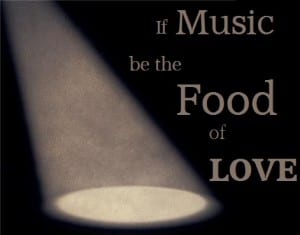Following an exercise to get us thinking about mood shifts and atmosphere, I have decided that I want to explore the relationship between music and feelings.
In my original idea I wanted lights to dictate the atmosphere of the room and music to guide the narrative. After a calm, mysterious voice from of stage says “You can come in now, if you wish” an accordion would start to play slowly and awkwardly creating a sense of discomfort. A bread roll would then roll into the spot-light. The silliness of the bread roll totally counteracts the awkward tension. As the accordion sped up I wanted the sharp white spot that indicates harshness and interrogation, to fade into a softer purple spot suggesting comfort and class. This would be the second shift in mood. It feels that these mood shifts are too brash and too contrasting for me and I would like to explore subtle changes in the elements of the piece, softly shifting the atmosphere. The use and implications of lights inspired me the most. It made me think of how I can dictate a mood with colour. What colours make you feel what? What sounds should accompany each colour?
As I was exploring the Twelfth Night quote ‘If music be the food of love’ I assigned different genres to various meals and drinks. For example, Pop – Champagne, R’n’B – Dessert and Classical – A roast dinner. This idea definitely made clear that music will feature in my piece but I felt it was too early to start putting my own feeling and emotion behind different types of music as this may hold back my exploration and creativity. Now I need to find a way to use music to evoke different emotions without telling the audience which emotions they should be feeling. I started to think about what colours could possibly contrast different types of music. What affect would a green colour scheme have on a love song?
Where is this going? What comes next?
These are the questions I found the hardest. This is why I had to make a U-turn and find the place where an idea was established but was still open to different directions. I do not want my piece to make a definite clear point that the audience will take away neatly in a box. I believe that this is too easy to produce and too easy for the audience. Despite this, I want my piece to have direction and a purpose and the way my initial idea was heading was interesting but it did not have enough structure. Finding the right structure and the right direction will make the rest of the piece easier to formulate and provide more to experiment with.
Shakespeare, W. (1968) Twelfth Night. Penguin: London.
